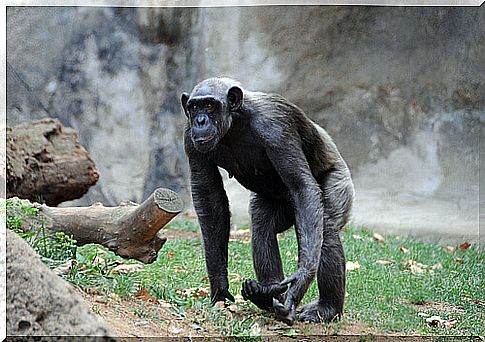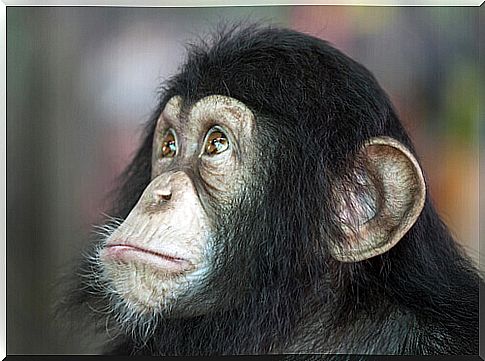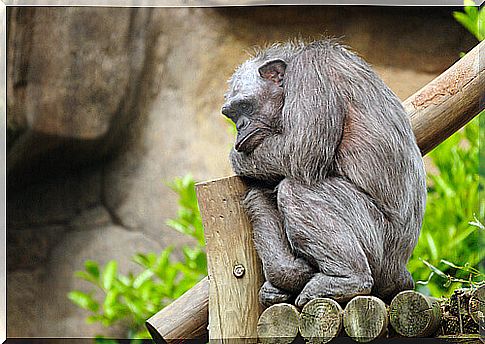The Chimpanzee: Characteristics, Behavior And Habitat

Chimpanzees are the animals that, from a genetic point of view, come closest to the human species. Apart from that, they also have a little known but very interesting social life.
When we talk about chimpanzees we are talking about one of the so-called great primates , that is monkeys with particular abilities and superior intelligence, linked to the human being due to an almost totally shared genetic background. Of all the primates belonging to the hominid family , they are the most famous. Unfortunately, their resemblance to humans has made them one of the most exploited species.
Currently there are still four subspecies of this beautiful animal, although all are quite similar : the western, eastern, central chimpanzee, and the Nigeria-Cameroon chimpanzee. Many of them share the territory with the gorilla, another species belonging to the great apes .
Characteristics of the chimpanzee
This species can weigh 70 kilograms in the case of males, because the females are small in size. This standing species can reach 160 cm in height, although the opening of the arms is considerably wider than that of the human species.

The arms of the chimpanzees are very long, which allows them to move with agility even with four legs or to climb and jump using the lianas of the trees present in the jungle.
Like man, they have opposable thumbs, which together with their marked intelligence, allows them to use stones as real tools. The big toe is also opposable, which makes their feet very versatile.
As for reproduction, pregnancy is similar to that of the human species and can last up to eight months. The young are weaned at three years, but it takes many more to become truly independent from their mother. In fact, they reach puberty at nine. Keep in mind that a chimpanzee can live up to 60 years.
As for food, their diet is mostly vegetarian, although they can eat meat. In fact, chimpanzees have amazing hunting techniques for capturing other primates such as the colobus . Its main predators are leopards, crocodiles and snakes, but its biggest threat is, unfortunately, the human being.
Habitat of the species
The chimpanzee is considered an exclusive primacy of Africa and its distribution has significantly reduced in recent centuries. This species is closely linked to the presence of wooded areas, as it normally lives in the tropical humid forest and in the savannah forests. Currently each subspecies occupies a niche on the continent:
- The western chimpanzee lives in southern Senegal, Ivory Coast, Nigeria, and Sierra Leone.
- The central one mainly occupies Gabon, Congo, Cameroon and Equatorial Guinea.
- The oriental variety lives in the same habitat as the previous one, therefore in Congo, but also in Burundi, Tanzania and Uganda.
- The areas where the Nigeria-Cameroon chimpanzee can be found are evident from its name.
Behavior of chimpanzees
Chimpanzees live in societies known as “fission-fusion”, in which reproduction is promiscuous and the combinations and number of members are highly variable. They can live in groups of 20 individuals and even reach 150 members.
In this species, males usually perform patrol activities, as well as keep competition for strength-based leadership high . However, given their extraordinary intelligence, sometimes a pragmatic elder manages to govern without violence, maintaining good relations with all members of the group. A truly unique attitude in the animal kingdom and which makes these beings even closer to man.
At other times, the control over the social group can also take place in very original ways. Primatologist Jane Goodall has documented the experience of a chimpanzee physically weaker but able to gain power by banging the camp bins. So he managed to assert himself by scaring other males simply through noise.

As for the personality, it should be noted that chimpanzees are quite aggressive animals and over the years, many violent fights between antagonistic social groups have been recorded. But an enormous empathy, sense of justice, and demonstration of true pain at the death of group members was also observed in this species .
Possible threats to the chimpanzee
This species has been exploited as a pet, hunted for its meat and plagued by diseases such as Ebola. To this we must add that the human being has often used it as a laboratory guinea pig, as a circus attraction or even in films and entertainment shows.
This is due to its enormous resemblance to us humans. In fact, one of the most exploited things is his fake smile: a chimpanzee who smiles like a human is terrified, not happy. And it’s something we constantly see in media and advertising.
Given their intelligence and the number of years they live with their parents (eight years), the premature separation that is made to be able to exploit them in all these activities, causes these animals an impossible trauma to overcome, because their mother- son is very deep and very similar to human.
Furthermore, the learning and socialization process, fundamental in childhood, is canceled. To all this we must add the fact that after 6 years they are considered dangerous and therefore abandoned in zoos or reinserted in their habitat. But re-education is practically impossible, with the risk of being marginalized for the rest of their lives.
Source of images: Carlos Octavio Uranga and David









